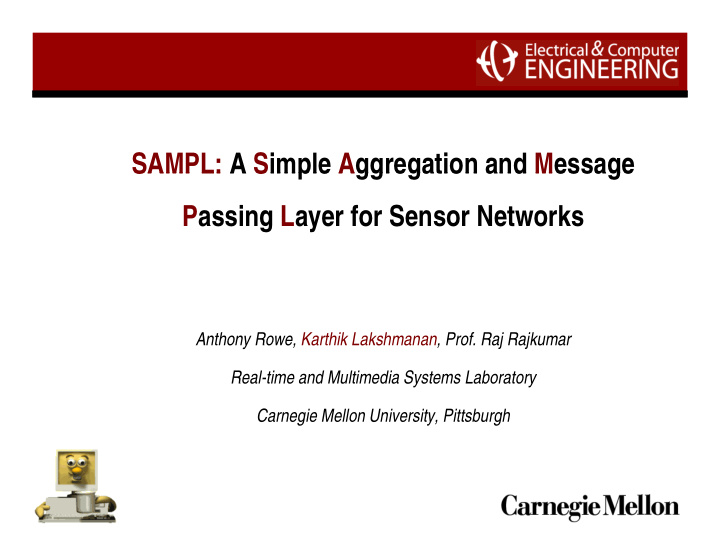



SAMPL: A Simple Aggregation and Message SAMPL: A Simple Aggregation and Message Passing Layer for Sensor Networks Real-Time Multiprocessor Scheduling p g Anthony Rowe, Karthik Lakshmanan, Prof. Raj Rajkumar Real-time and Multimedia Systems Laboratory Real time and Multimedia Systems Laboratory Carnegie Mellon University, Pittsburgh
Goal: Make Carnegie Mellon the most sensed campus p g Sensor Andrew
Current Deployment Statistics Key (Number of Sensors per Node Type) Key (Number of Sensors per Node Type) = 1 = 2 = 3 Current Status: 1500 Sensor Points deployed across campus (over 7 months) p y p ( )
Health monitoring and maintenance for buildings on campus p g Infrastructure Monitoring g BACnet
Total Household Energy Consumption in the US: 10.6 Quadrillion BTUs Q p gy “Green” - House
Outfitting the on-campus solar challenge test-bed with Wireless HVAC g p Solar House g Hobo Sensors
Intelligent “ID” cards for access to buildings on campus p g Access Management g
Localization Services Where to get “fresh” Pizza? Where is the nearest Rest-Room? Which conference room is free? Is this Coffee fresh? Is this Coffee fresh? OMG!!! Can’t find class room!!! Localization services for both Humans and Robots
Hardware Infrastructure D Cell Node AA Cell Node Development Node Gateway Node Sensor Andrew also provide infrastructure support for other technologies p pp g
“Big” - Picture Campus Ethernet N t Network k End-User Server Ethernet / 802.11 Ethernet 802.11 Gateway Gateway IP Camera Agents End-User RS-232 RS-232 Sensor Sensor PC Node Node Node Node Mobile RFID RX Node 802.15.4 S Sensor Bluetoo Card th * Protocols listed are examples p Sensor Andrew provides a complete infrastructure for ubiquitous sensing/control
Gateway acts as a bridge to the Internet and uses an XMPP infrastructure “SAMPL” - Picture
“SAMPL” - How? Data Report Flash Configuration Flashing re-establishes paths. Level-delayed data report enables aggregation
Why – “SAMPL”? Energy Efficient: Configurable sleep duration Aggregation Aggregation Mobility Support Wait for next Flood Robustness Robustness - Paths re-establish with each Configuration Flash - Weak paths are removed during each Flash
Configurability Adaptability & Budgeting: Mandatory for long-term sustainable sensor networks Adaptability & Budgeting: Mandatory for long-term sustainable sensor networks
Visibility Accurate Accounting – Enables lifetime prediction and maintenance schedules Accurate Accounting – Enables lifetime prediction and maintenance schedules
Deployment issues – Practical problem of ensuring wireless coverage g g p p y Deploy
Run-time Visibility - key aide in a successfully developing Sensor Andrew p g y y y Debug
Correlated packet loss helps identify the bottlenecks in the network y p p Monitor Health
Find the weakest links of the chain Diagnose
Fortify the network by “strategically” adding nodes g y g y y Re-enforce
Evaluate After Re-Enforcement Before Re-Enforcement 12% improvement from an average packet delivery rate of 82% to 94% p g p y
Conclusions � Key features of SAMPL � Configurability, Visibility, Mobility support and Energy efficiency � Flexibility to support a diverse-set of applications � Civil-engineering research, Robotics applications, Mobility studies � Large-scale and Long-term deployment � 1500 sensing points deployed over a seven month duration 1500 i i t d l d th d ti � Efficient techniques to ensure coverage � Mature infrastructure for diagnostics and debugging � Mature infrastructure for diagnostics and debugging � SAMPL provides infrastructure support for Sensor Andrew
Demo � For more details: � For more details: � http://www.nanork.org � http://sensor.andrew.cmu.edu htt // d d � Questions: � agr@andrew.cmu.edu � klakshma@andrew.cmu.edu � raj@ece.cmu.edu
Recommend
More recommend